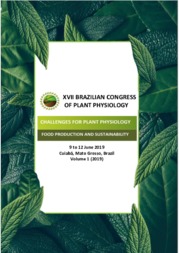Light curve of young Brazil nut plants grown under different luminosity conditions.
Light curve of young Brazil nut plants grown under different luminosity conditions.
Autoria: SILVA, A. C. da; BORELLA, D. R.; SANTOS, L. M. M. dos; BOUVIÉ, L.; SILVA, K. N. C.; BEHLING, M.; ARANTES, R. F. T.
Resumo: The incidence of different intensities of solar radiation on plants directly influences the net assimilation of CO2, and consequently on plant growth and development. The aim of the current study was to investigate carbon assimilation in 2-year-old Bertholletia excelsa seedlings subjected to different irradiance environments in the Cerrado-Amazon transition zone (Mato Grosso State), from June to August 2017. Seedlings were acclimated on polyolefin screens for 6 months, under different quantitative (35%, 50%, 65% and 80%) and qualitative (thermo-reflective, red, blue and green screens, at 50% shading) levels and under full sun. An ADC BioScientific LCi-SD photosynthesis analyzer - at light intensity ranging from 0 to 2000 μmol m-2 s-1 ? was applied to fully open leaves in order to analyze the following parameters: leaf temperature (Tleaf), transpiration (E), photosynthesis (A), CO2 concentration in the substomatal chamber (Ci) and stomatal conductance (gs). The experimental design was completely randomized with ten repetitions (seedlings). Significant (p < 0.05) cubic and/or quadratic polynomial regressions were adjusted to different parameters and shading screens. The highest A, Ci, E and gs rates were recorded for blue and green screens, whereas the lowest values were recorded for the thermo-reflective screen. The highest A, E and gs rates in black-screen environments were recorded for 80% and 65% shading screens, whereas Ci was observed in full-sunlight and 35%-shading environments. Overall, the full sunlight condition recorded the lowest rates for all photosynthetic parameters. We conclude that B. excelsa seedlings grown in quantitative-qualitative environments with irradiances between 500 and 1250 μmol m-2 s-1 allow the greatest gas exchange.
Ano de publicação: 2019
Tipo de publicação: Resumo em anais e proceedings
Unidade: Embrapa Agrossilvipastoril
Palavras-chave: Brazil nuts, Mato Grosso, Photosynthesis, Sinop-MT, Transpiration
Observações
1 - Por padrão são exibidas publicações dos últimos 20 anos. Para encontrar publicações mais antigas, configure o filtro ano de publicação, colocando o ano a partir do qual você deseja encontrar publicações. O filtro está na coluna da esquerda na busca acima.
2 - Para ler algumas publicações da Embrapa (apenas as que estão em formato ePub), é necessário ter, no celular ou computador, um desses softwares gratuitos. Sistemas Android: Google Play Livros; IOS: iBooks; Windows e Linux: software Calibre.
Acesse outras publicações
Acesse a Base de Dados da Pesquisa Agropecuária (BDPA) para consultar o acervo completo das bibliotecas da Embrapa.

